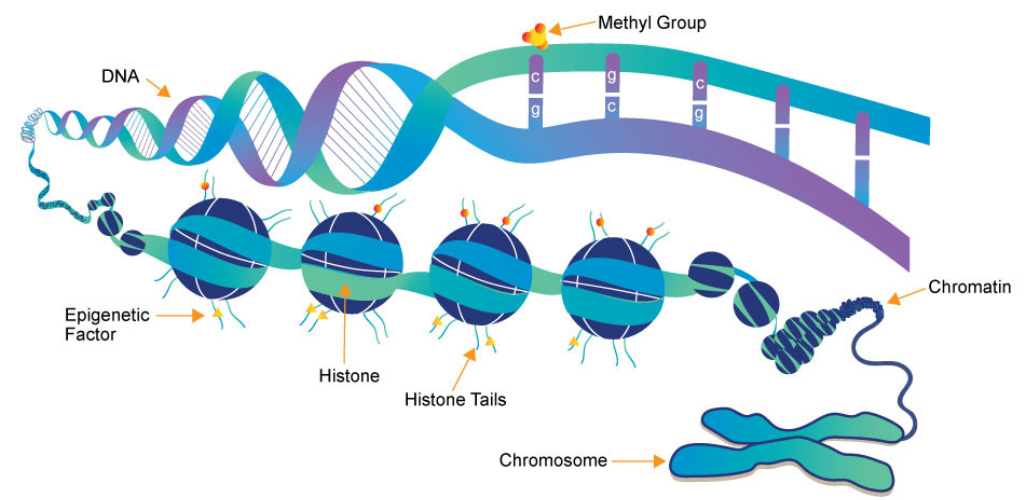Epigenetics, a burgeoning field within genomics, plays a pivotal role in the intricate dance of genomic regulation. This detailed blog navigates through the fundamental concepts, mechanisms, and profound implications of epigenetics in shaping the dynamic interplay between genes and their environment.
Epigenetics and Its Role in Genomic Regulation
Epigenetics, a field of study within genetics, focuses on heritable and stable changes in gene expression that occur without altering the DNA sequence. These changes are reversible and can be influenced by various factors such as age, diet, environment, and disease state. Epigenetic mechanisms play a crucial role in regulating gene expression and are involved in processes like cellular differentiation, tissue development, and environmental-induced disease aetiology.
Epigenetics is also associated with transgenerational inheritance, where epigenetic changes can be passed on to the next generation. This phenomenon has implications for understanding how environmental factors can influence gene expression and disease risk across generations.
The interplay between genetics and epigenetics is critical for the regulation of gene expression and the development of an organism. While genetics provides the primary control for the regulation of genome activity, epigenetics complements this by offering an additional layer of molecular control. This integrated control involving both genetic and epigenetic factors ensures a more robust and thorough regulation of development.
What are the different types of epigenetic modifications
Epigenetic modifications are chromatin changes influencing gene expression without altering DNA. Two primary types are DNA methylation and histone modifications.
- DNA Methylation: Adds methyl or hydroxymethyl groups to DNA, often at cytosine C5 positions (m5c). It can silence genes and is measured by ChIP or bisulfite methods.
- Histone Modifications: Adds or removes chemical groups like methyl or acetyl to histones, affecting DNA wrapping and gene expression.
Noncoding RNA action is another epigenetic process influencing gene expression, crucial in biology and implicated in diseases like cardiovascular disease.
How do environmental factors affect epigenetic regulation
Environmental factors can affect epigenetic regulation by altering DNA methylation, histone modifications, and noncoding RNA expression. Exposure to environmental toxins, such as metals, air pollution, benzene, organic pollutants, and electromagnetic radiation, can alter epigenetic marks. Other environmental factors, such as diet, stress, and lifestyle habits, can also influence epigenetic regulation.
During foetal development, epigenetic profiles are being set, and critical windows are narrow, making the in utero period particularly sensitive to environmental exposures[2]. Studies have shown that environmental exposures during this period can alter DNA methylation and microRNA expression, leading to changes in gene expression and disease risk.
The extent to which environmental factors can provoke epigenetic responses is still being studied, but it is clear that epigenetic mechanisms allow an organism to respond to the environment through changes in gene expression[3]. Understanding the impact of environmental factors on epigenetic regulation is essential for developing strategies to prevent and treat diseases that arise from environmental exposures.
What are some examples of environmental toxicants that can alter epigenetic regulation
Some examples of environmental toxicants that can alter epigenetic regulation include:
- Bisphenol A (BPA): BPA is an environmental chemical that has been shown to alter histone H3K4me3, histone acetylation, and DNA methylation, leading to epigenetic alterations.
- Endocrine-Disrupting Chemicals (EDCs): EDCs such as diethylstilbestrol (DES), persistent organic pollutants (POPs), and bisphenol A (BPA) have been associated with changes in DNA methylation and histone modifications, affecting epigenetic regulation[3].
- Cigarette Smoke: Environmental exposure to cigarette smoke has been linked to alterations in DNA methylation and histone modifications, particularly during the in utero period, impacting epigenetic regulatory features.
- Toxic Trace Metals: Exposure to toxic trace metals, such as arsenite, lead (Pb), and others, has been associated with changes in DNA methylation and histone modifications, influencing epigenetic regulation.
Conclusion :
In conclusion, the intricate interplay of epigenetics and genomic regulation unfolds a realm where environmental factors intricately shape gene expression. Environmental toxicants, such as BPA and EDCs, wield the power to alter epigenetic marks, influencing disease susceptibility. Understanding these dynamics is paramount for mitigating health risks and advancing strategies for personalised prevention and treatment.
Citations:
[1] https://www.ncbi.nlm.nih.gov/pmc/articles/PMC5703206/
[2] https://www.ncbi.nlm.nih.gov/books/NBK532999/
[3] https://www.nature.com/articles/ng1089z
[4] https://www.cdc.gov/genomics/disease/epigenetics.htm
[5] https://www.frontiersin.org/articles/10.3389/fgene.2021.675780/full
[6] https://www.cdc.gov/genomics/disease/epigenetics.htm




